features
How to cook with wild garlic – a Twisted guide
01 Mar 2023
14m
It’s just starting to sprout up everywhere, but can you eat wild garlic, how do you cook with it and how do you grow it?
You’ve may have seen it on menus up and down the country – mixed into mayos and ground into punchy pestos – but those who aren’t in the know could be forgiven for thinking that the spring herb is just a weed, or not really knowing where to start with it at home.
Fear not, though! We’ve compiled a guide to prepping, cooking and eating the stuff – because, once you know how to use wild garlic properly, we have a feeling you’ll be just as hooked as us.
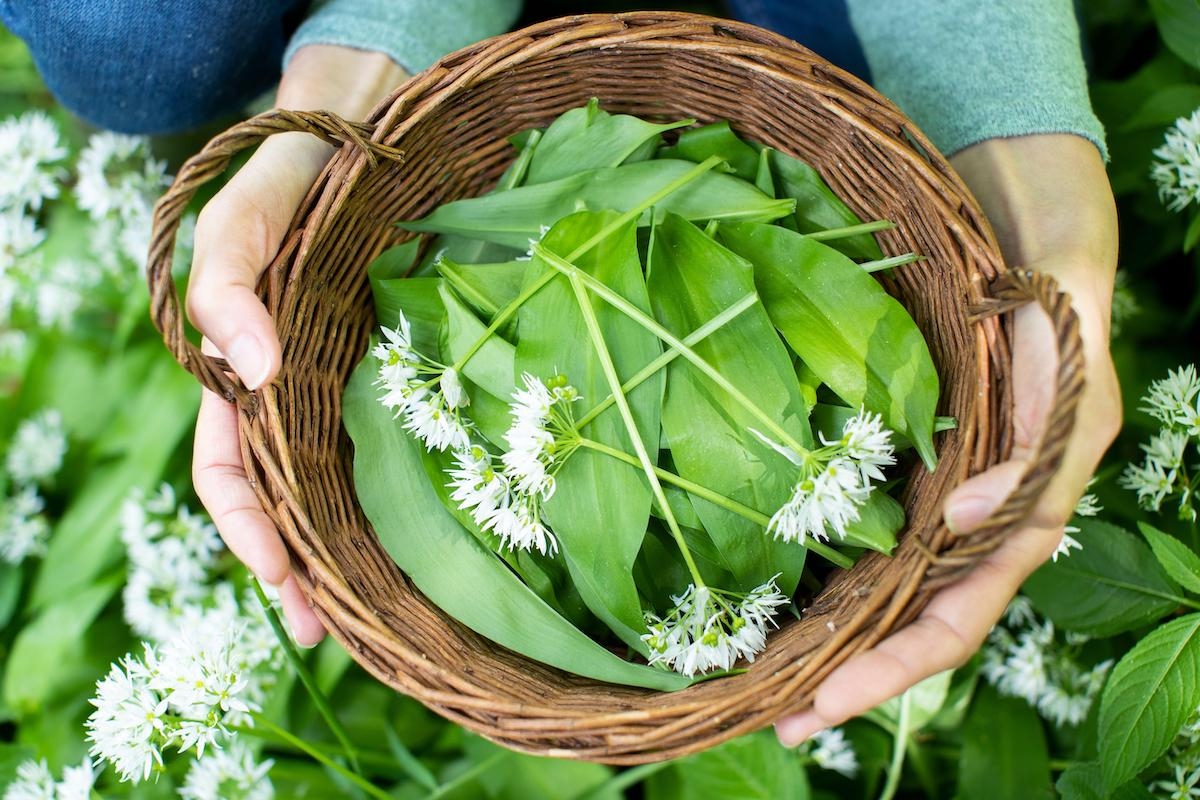
If you haven’t tried wild garlic, this is your sign (Credit: Alamy)
READ MORE: Try Twisted’s Buffalo Chicken Garlic Dough Ball recipe
What is the difference between garlic and wild garlic?
Both garlic and wild garlic (also known as ramsons or cowleekes) are leafy bulbous plants. However, whilst garlic is originally native to South Asia, Central Asia and northeastern Iran, wild garlic is native to Britain.
It can today be be found in woodland across Europe, and is part of the allium family – much like leeks, onions and (naturally) garlic, too.
Even from a mile off, wild garlic has got a very distinctive garlic and onion smell that will alert you of its presence, but when it comes to taste, it’s actually sweeter and a lot milder than normal garlic. You could call it the plant’s sophisticated and more refined sibling.
Unlike garlic, many gardeners would dub wild garlic a weed due to its inclination to infiltrate flower beds when uninvited. But, trust us, anybody throwing this plant away is making a big mistake.
What does wild garlic look like?
We’re sure you’ll have no trouble sniffing out the pungent plant before you even see it, but you can also spot its distinctive bright green leaves with flat edges.
Its white, star-shaped flowers are also a tell-tale sign, when they begin to bloom.
READ MORE: Twisted’s Vegetarian “Meatball” Sub with Garlic Bread Recipe
In the right conditions, wild garlic leaves can even grow as tall as 50cm in some cases, making it easy to spot if you go out looking.
Just be careful not to confuse it with another wild plant (more on that below)…
Which type of wild garlic is poisonous?
This is a common misconception, but it’s a whole lot of panic over nothing. Wild garlic is not poisonous – full stop.
The reason people think this is because it’s commonly mistaken for Lily of the Valley (which isn’t a type of wild garlic, it’s another woodland flowering plant).
The best way to tell the difference is to look at the flower. Lily of the Valley has bell shaped petals which are different from wild garlic.
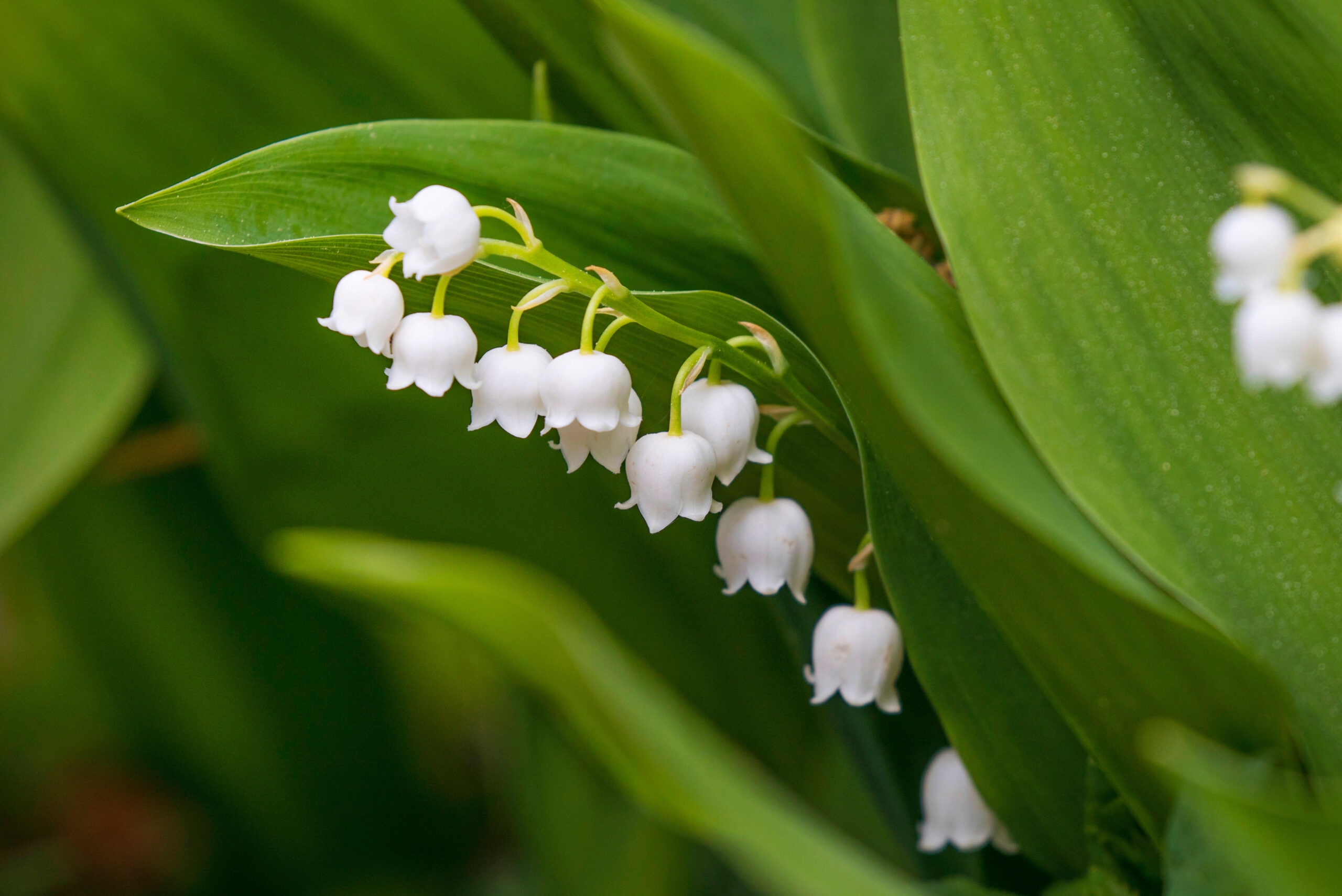
Lily of the Valley’s leaves differ (Credit: Alamy)
The National Trust warns: “Please note: wild garlic looks quite similar to lily of the valley – which is poisonous. If you’re in any doubt about which plant you’ve found do not eat it.”
Another way to tell you’ve picked the correct plant is to pick a leaf and crush it in your hand then give it a sniff. If you don’t get a strong whiff of garlic, you’ve got the wrong guy.
Is wild garlic safe to eat?
Good news! As a rule, wild garlic is completely safe to eat (do you think we’d be doing a guide about how to cook it, otherwise?).
As with any ingredients, there are some exceptions to the rule.
READ MORE: Twisted’s Crispy Mexican Garlic Falafel Recipe
If you’re taking blood-thinning medication or know you have a condition that’s impacted by blood thinning then the official guidance is to keep clear (or check with your doctor).
Those who are allergic to the onion family should also avoid wild garlic, and if you’re intolerant to other types of allium (like leeks, spring onions, green onions etc) then take care, too.
When is wild garlic season?
Wild garlic season falls between March and June, making it a springtime staple on many menus.
If you’re looking to cook with the leaves, the best time to harvest it is earlier in the season, when they are still young.
Meanwhile, wild garlic flowers are best enjoyed from April onwards (more on how to cook both of these below).
The time you have to harvest wild garlic leaves is relatively short, but due to the fact you can use the whole plant, wild garlic actually has one of the longest seasons of all wild herbs.
This means there’s ample opportunity to get creative with it. Go on, you know you want to…
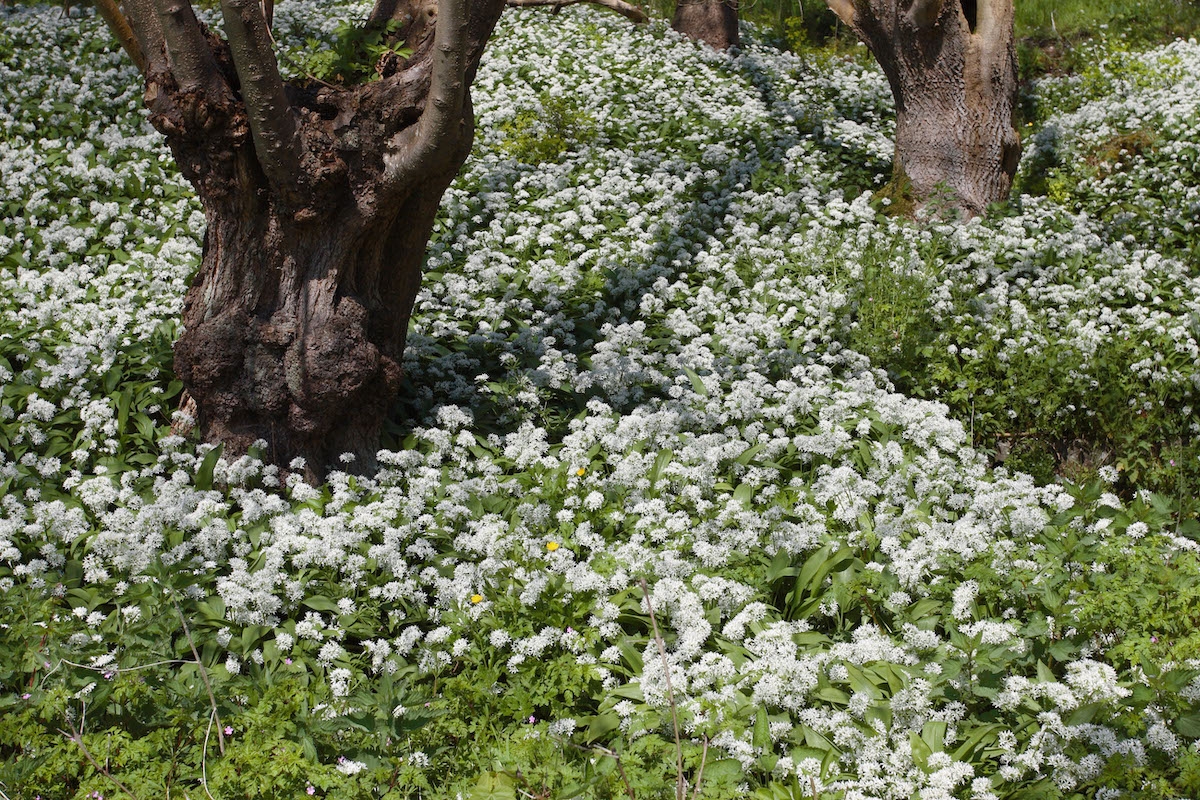
This is what you’re looking for – wild garlic (Credit: Alamy)
Where to find and pick wild garlic in the UK
Wild garlic is most commonly found in UK woodlands, as well as by books and streams.
It especially thrives where there is shade and where the ground is damp, and when it’s in season it can literally coat patches of habitable land.
If you’re looking for a patch of wild garlic near you, it’s worth noting that the plant is also partial to slightly acidic soil, meaning you might well find it alongside bluebells, which flourish in similar conditions.
READ MORE: Twisted’s Creamy Garlic Mushroom Tagliatelle Recipe
For those hunting for a sure-fire wild garlic spot, the National Trust suggest the following UK sites:
- Downhill Demesne, Northern Ireland – a cliff-top estate on the north coast of Northern Ireland where wild garlic thrives in spring.
- Erddig, Wrexham – you can find woodlands packed with wild garlic in this Welsh countryside spot.
- Fowey Estuary, Cornwall – The Fowey Estate in Cornwall is full of wild garlic every year, especially in the woodland’s shadiest spots.
- Newark Park, Gloucestershire – Wild garlic packs this park in Gloucestershire in April and May, making it the perfect place to catch a whiff.
- Ilam Park and Dovedale, Derbyshire – You can find wild garlic if you venture along Paradise Walk and down to the River Manifold.
Given how abundant wild garlic is, we can pretty much guarantee there will be some near you, too.
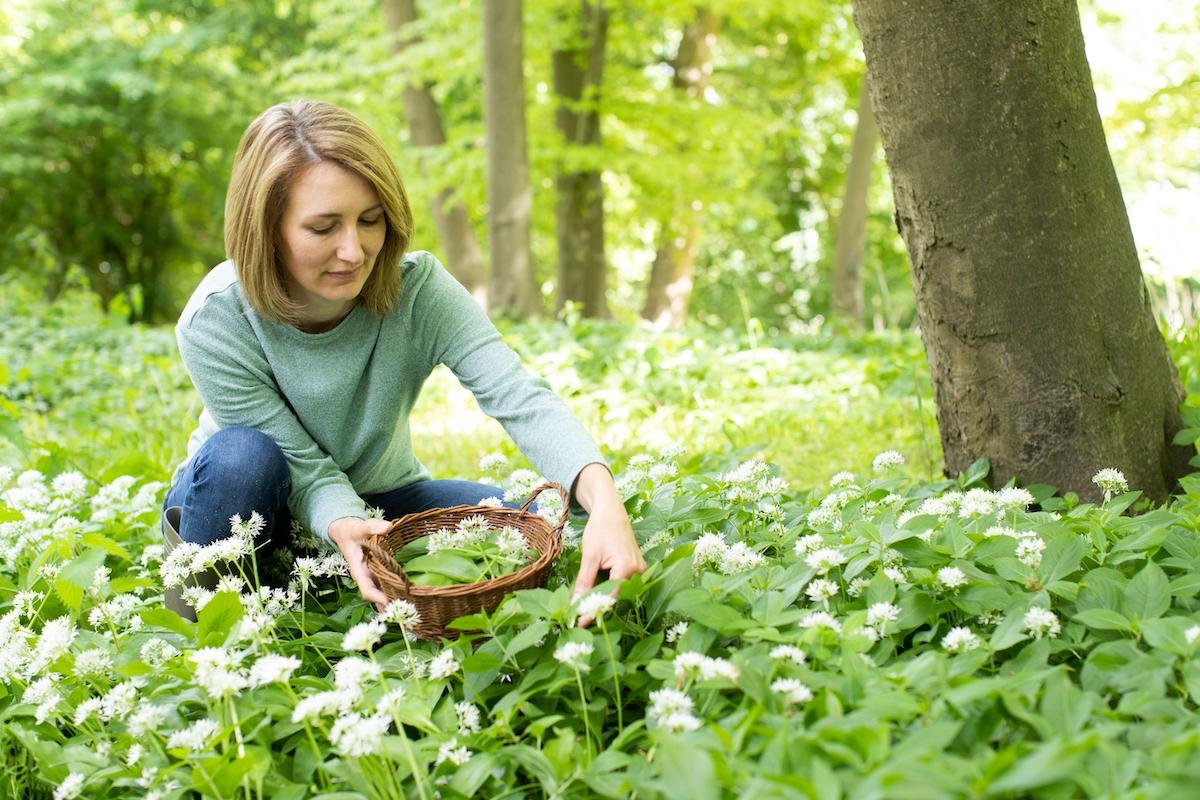
Foraging wild garlic is actually easy (Credit: Alamy)
How to pick wild garlic
You’ve identified your ramsons – but how to pick them? There are a few tips and rules to remember.
To pick wild garlic properly, it’s worth noting the following:
- Check you have permission to forage in a certain area – do your research and ask the land owner if it isn’t a public place.
- Unless in your garden, use scissors or your hands to pick the leaves as close to the ground as possible, without uprooting the whole plant. This is because it’s illegal to dig up bulbs of wild garlic from public ground, as this means it won’t grow the following year.
- Pick from areas that have a large supply so you aren’t ridding a spot of wild garlic altogether, where possible.
You can check out the Woodland Trust’s sustainable foraging guidelines for more tips.
Is wild garlic illegal?
Obviously wild garlic isn’t illegal (we promise, that’s not how we roll). However, it is illegal to dig up bulbs of wild garlic from public ground, as this means it won’t grow the following year.
There’s a way around this, though. Unless in your garden, use scissors or your hands to pick the leaves as close to the ground as possible, without uprooting the whole plant.
READ MORE: Twisted’s Buffalo Chicken Garlic Dough Balls Recipe
Also, check you have permission to forage in a certain area. As a common courtesy, do your research and obviously ask the land owner if it isn’t a public place.
Wild garlic is for everyone, so long as you forage it properly. Simples.
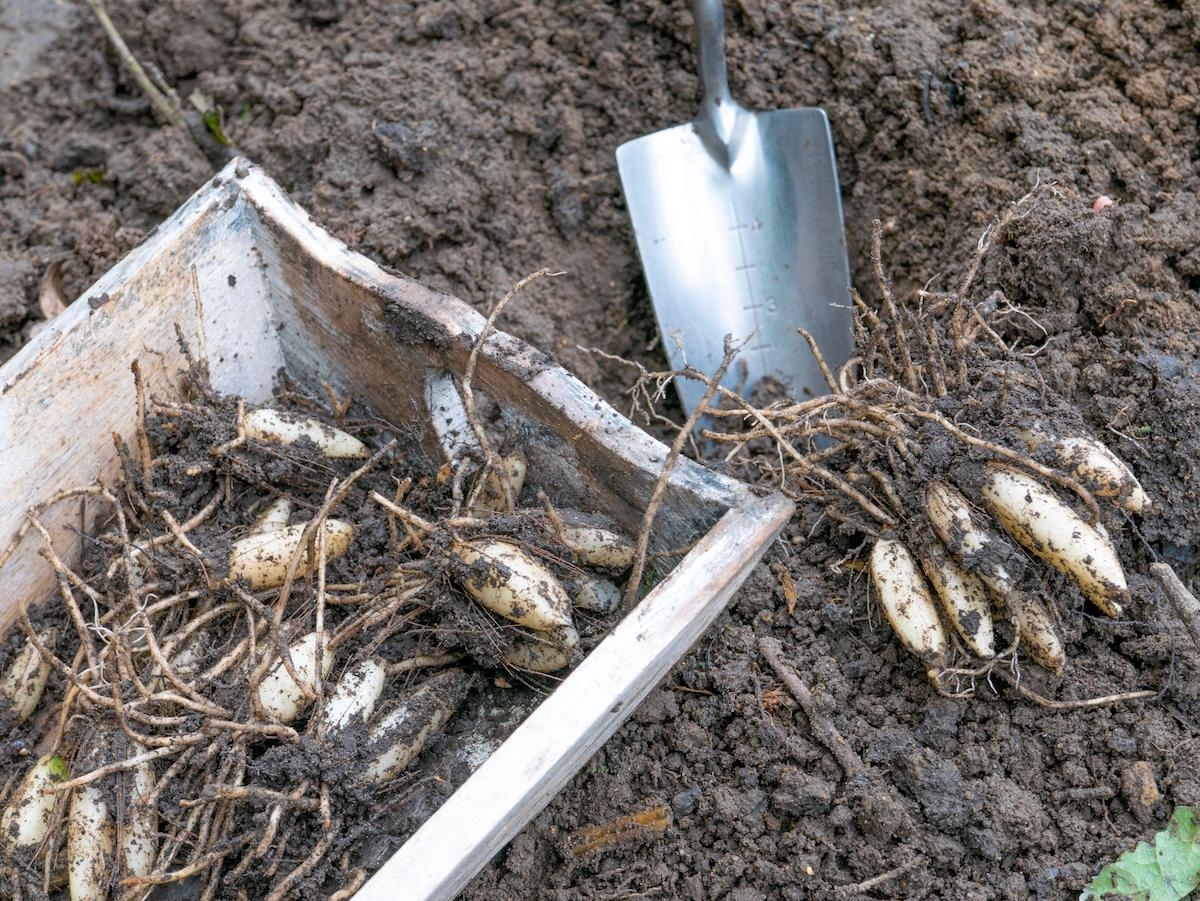
Don’t dig up ransoms from public places (Credit: Alamy)
How to grow wild garlic
It’s really easy to grow wild garlic by planting wild garlic bulbs where you want the plant to sprout. The best time to do this is from October to mid March and this is the quickest method, with results expected one year after planting.
You can buy bulbs online from several sites, and there’s a bunch on Amazon, too.
You can also start your plants from seeds, which are cheaper – but, if you go for this method, you’ll have to wait about four years for results worth harvesting.
The best way to grow your wild garlic is to clump it together rather than try to plant it easily in rows, and sow it about 1cm deep in the ground.
Once you’ve had one successful crop it’s perennial, which means it comes back every year. Winner!
Where to buy wild garlic
If you CBA to grow wild garlic, or don’t fancy becoming a forager any time soon, you can also just buy the stuff.
You can usually purchase it when it’s in season from up-market supermarkets like Waitrose (£3.25) – just be sure to check the herb aisle.
READ MORE: Twisted’s Roasted Garlic Chicken & Mushroom Orzo Recipe
Plus, you can purchase from organic shops, as well as online. Riverford Organic sell the herb for £3.30, picked straight from a farm in Devon, whilst select cooking ingredient websites, such as Fine and Wild, are a great resource for the product when it sprouts, selling a 150g bunch for a fiver.
As well as the fresh stuff, Waitrose even sell frozen wild garlic for £1.75 so you can enjoy it all year round.
Whilst it isn’t as readily available as most herbs, it’s worth checking your local shops and the world wide web before going digging through the woods, if you don’t fancy getting your hands dirty.
How do you prepare wild garlic to eat?
Whatever you’re doing with the herb, first gently clean off any soil with water, if you’ve foraged it.
Then, pat dry with a tea towel or kitchen paper being sure to be gentle with the leaves and flowers to they remain in good condition to use in your cooking.
As far as preparation goes, that’s pretty much all you have to do.
We told you this was a cracking ingredient!
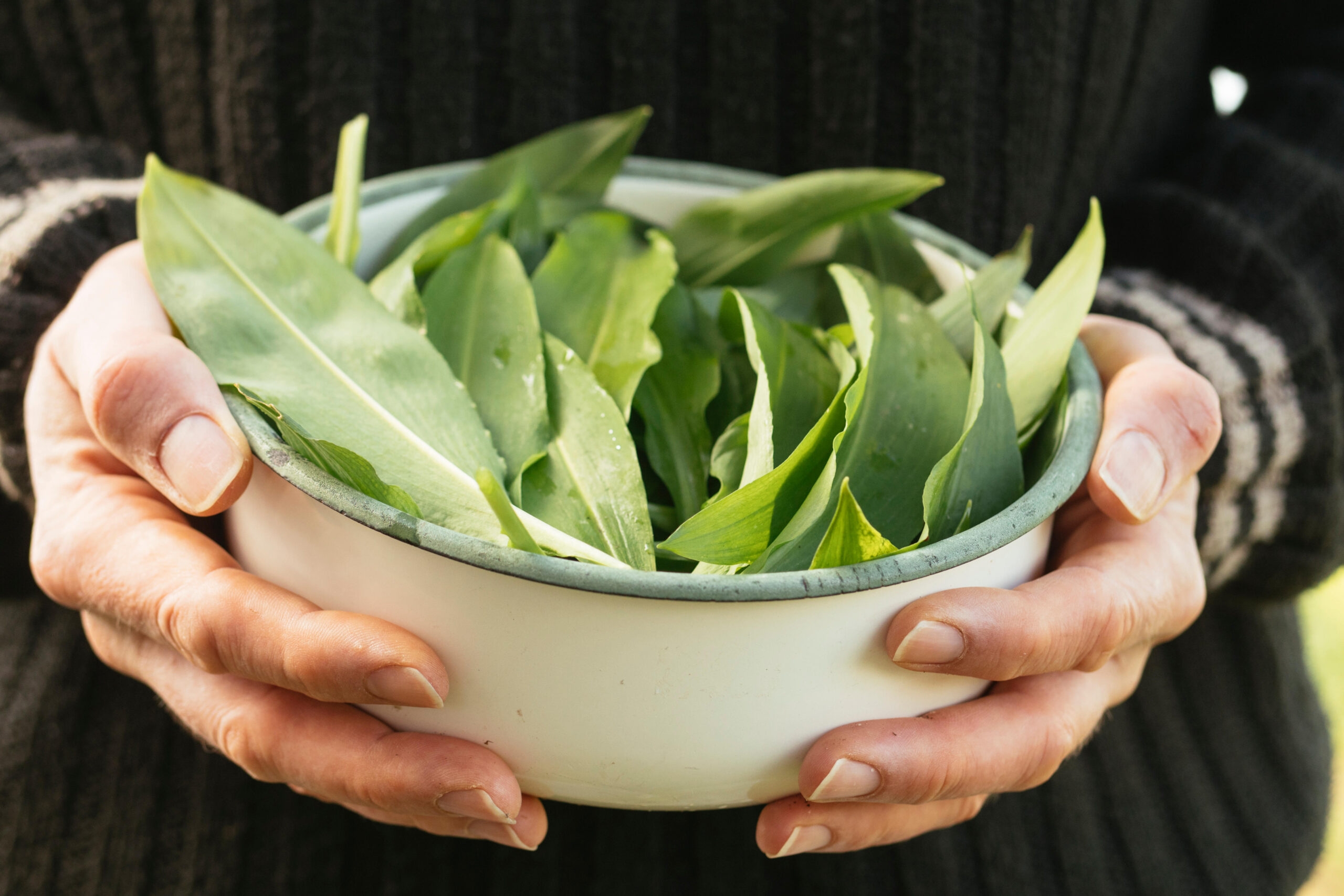
Wild garlic is an ancient herb (Credit: Alamy)
What part of wild garlic do you cook with?
The best thing about wild garlic is its versatility. The stem, bulb, leaves and flowers of the plant are edible, making it a great ingredient to spruce up your dishes when it’s in season.
Each part of wild garlic has different flavours and uses. Whether you want to eat the leaves raw in a salad or cook them, use the crushed bulb as a seasoning or in dressings or embellish your dishes with the flowers, the possibilities are pretty endless when you’ve got yourself a stock of ransom.
The most important thing is knowing how to get the most out of each element, so you don’t waste your supply.
There’s no need to bin anything here, so cooking with wild garlic is really sustainable option.
How to cook with wild garlic…
When cooking with wild garlic, chef Christoffer Hruskova suggests plunging the plant into iced water, so it is as vibrant in colour as possible.
After that, wild garlic leaves can be blanched for anywhere from 30 seconds to a minute before use in recipes, which further mellows its flavour and brings out the plant’s delicate nature.
You can also steam the leaf in a little butter (chef Nigel Slater recommends this method).
It’s worth noting that when cooking wild garlic, it will shrink a lot like any leafy green, so stocking up is encouraged.
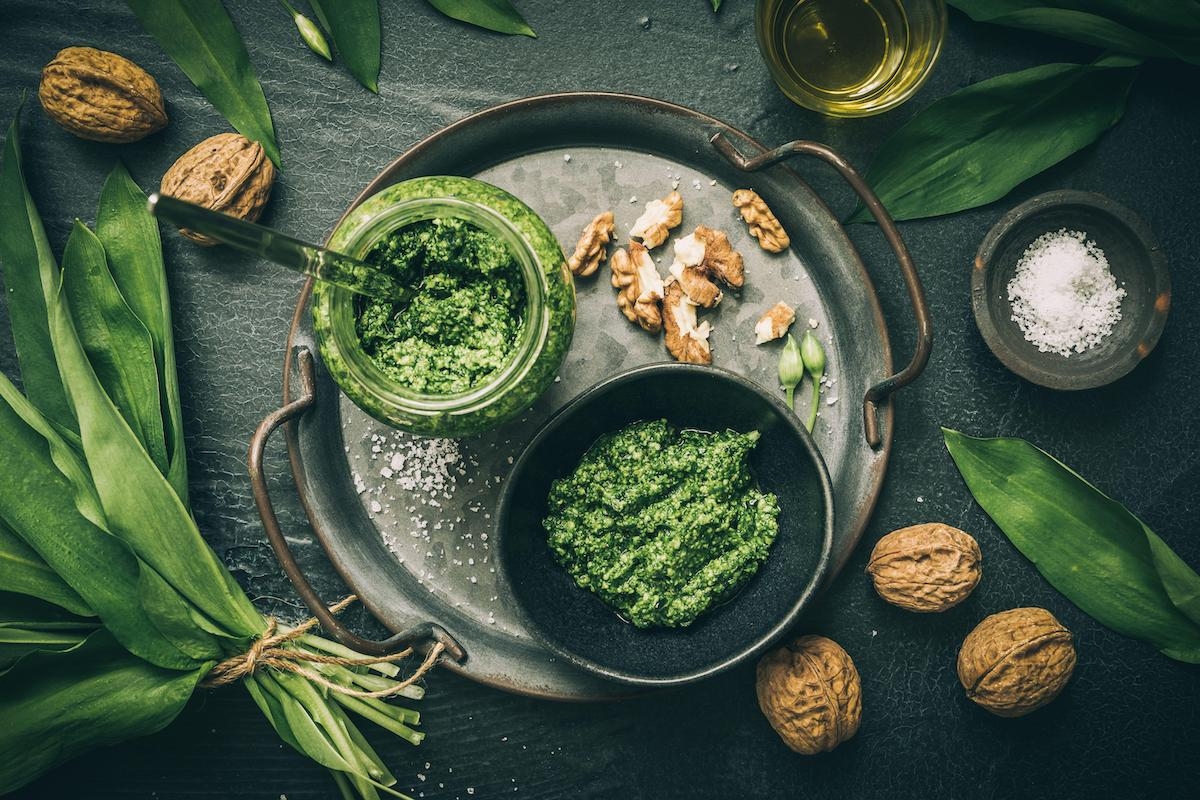
Wild garlic can be made into a pesto (Credit: Alamy)
READ MORE: Try Twisted’s Meatball Sub Garlic Bread recipe
The milder flavour of wild garlic when cooked even for a few seconds means it is best used in recipes that don’t involve a lot of cooking, as this will further reduce its pungency.
That’s why there are also a lot of recipes that call for wild garlic leaves as they are (without any heat added to them first) – most commonly when they’re blitzed up in a pesto or chopped up in a salad.
Not only that, but the flowers make great garnishes, the bulbs can be crushed and used in place of traditional garlic and the stems can be swapped into recipes as you would a spring onion or chive. The wild garlic plant really is a versatile beast.
If you need some further inspo, read on for a few suggestions from the experts...
What does wild garlic go with?
Wild garlic pairs particularly well with ingredients that are available around the same season, like Jersey Royal potatoes, asparagus, spring lamb.
However, there is no limit to its uses. Chef Yotam Ottolenghi pairs the herb with warm mackerel and potato – a recipe he says “makes the most of its mild, sweet smokiness”. Meanwhile, Angela Hartnett suggests adding it to a courgette and mint soup for a “deliciously fresh” spring recipe.
Tom Kerridge wilts wild garlic leaves and adds them to a new potato salad, whereas, like many others, Jamie Oliver makes a cracking pesto out of it, which you can pair with pretty much anything.
Here’s what some of our Twisted chefs recommend:
Spencer, Twisted Food Producer
“Unsurprisingly to my fellow Twisted chefs, I love using wild garlic in a green sauce. Pesto, salsa verde, chimichurri…the lot. It pairs really well with acidity – especially lemon.
“Served over any sort of grilled meat or vegetable, it’s divine. If you want something more comforting, it’s great blended up with kale and peas in a spring greens risotto.”
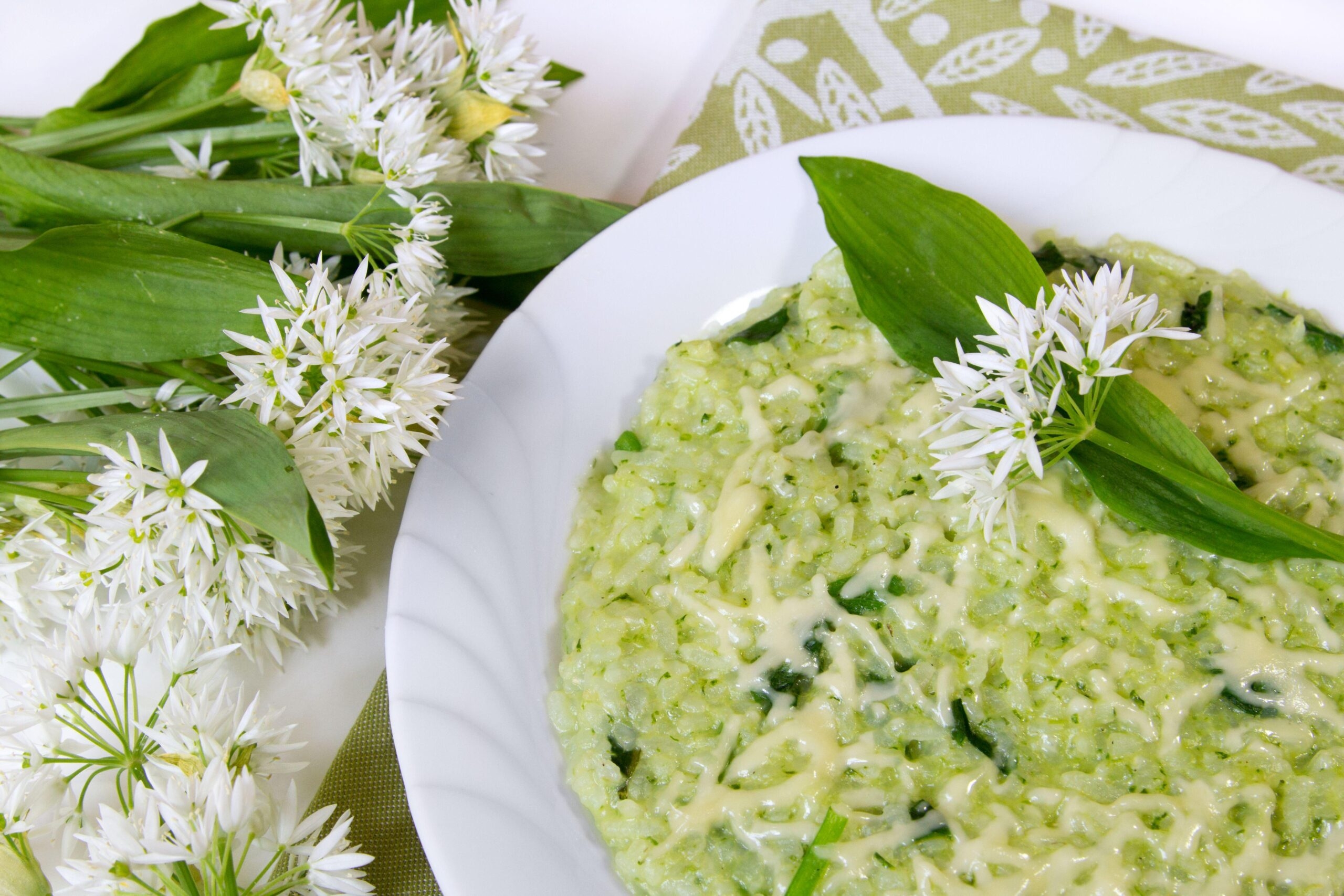
Wild garlic risotto is a great way to use the herb (Credit: Alamy)
Mia, Twisted Green Brand Lead
“The viral Tunacado Sandwich (inspired by Joe and the Juice) is everywhere right now, and I keep thinking how damn good it would be with some of Twisted Green’s chickpea tuna and a stunning wild garlic pesto in there! Because, let’s face it, homemade vegan pesto will always trump the shop bought stuff.
“Wild garlic vegan mayo has to be up there for me as one of my favourite ways to eat wild garlic, too. Simply blanch the leaves then blend with aquafaba, oil, a pinch of salt and some lemon juice. Simple, and works well with everything!”

Make a mayo from scratch of blend wild garlic into some (Credit: Alamy)
Hugh, Creative Culinary Lead
“Personally, I love a cheeky forage. It’s nice to eat with some awareness of the seasons, be that sloe gin, elderflower cordial or (of course) wild garlic season.
“The latter is so versatile – as the pungent frontman in the classic pesto, wilted into a broth with some poached chicken or chopped up with some capers and anchovies in a spring salsa verde. Get out there and find some! Just don’t mistake it for lily of the valley and get poisoned! Cheers.”
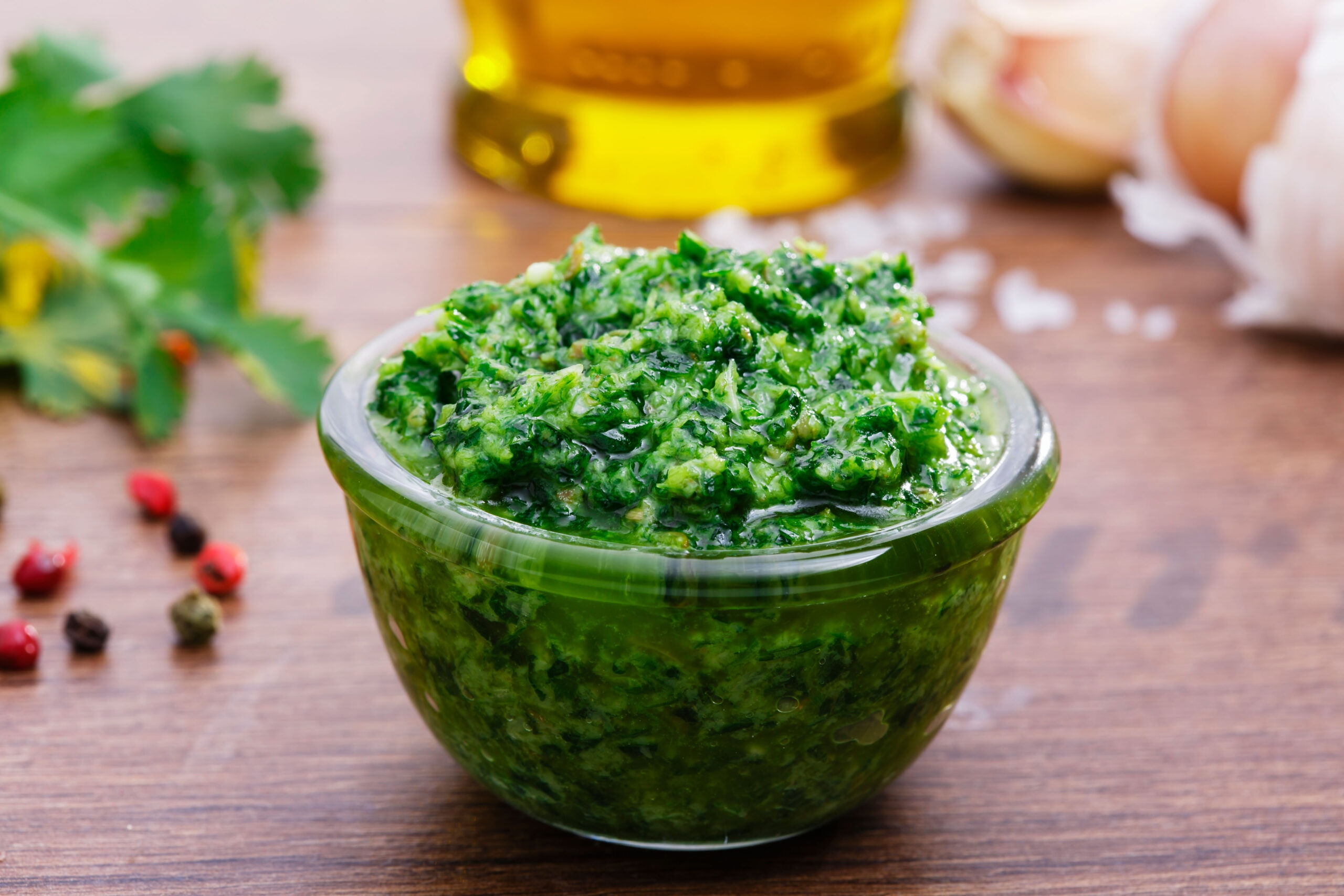
Anyone for Salsa Verde? (Credit: Alamy)
How to store wild garlic…
Wild garlic keeps in the fridge for a couple of days after you forage it, and is best kept in an airtight Tupperware so it stays fresh.
However, you can also preserve the seasonal herb a little longer by putting the stem in a glass of water or wrapping it in a moist kitchen towel and popping that in the fridge.
Other ways to make wild garlic last longer include pickling its buds (simply pop it in a jar with some apple cider vinegar and sugar) and fermenting the herb (this is a little more complex, but find some tips here).
Also try putting it in oil (this also infuses the oil beautifully for dressings, cooking and garnishing), blending it with nuts, oil and cheese to make a pesto or even making a wild garlic salt. There’s a quick recipe for the latter below:
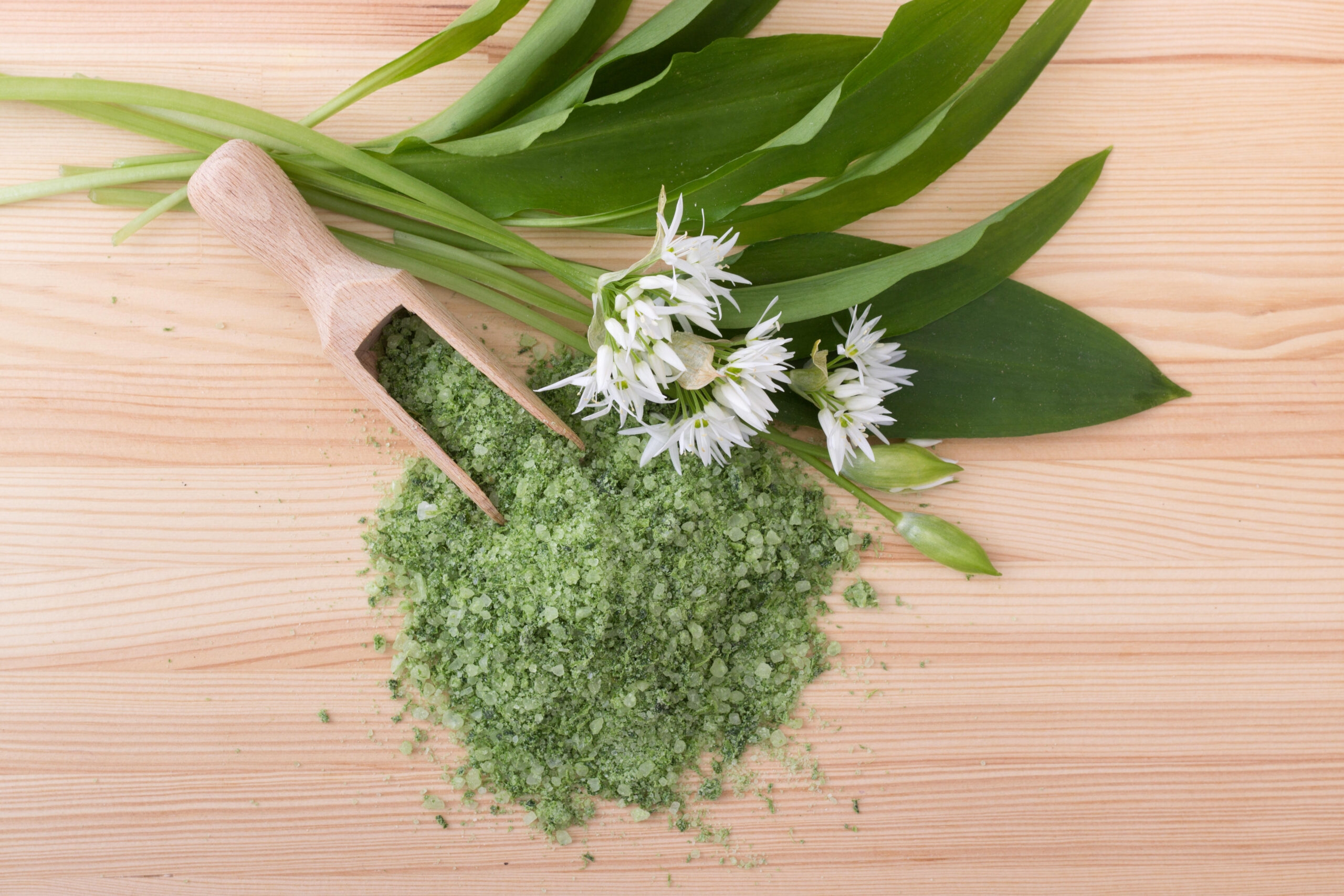
Wild garlic salt is another way to preserve ransoms (Credit: Alamy)
Wild Garlic Salt
You’ll need:
- 300g of good quality, coarse flaked salt
- A large bunch of wild garlic (roughly 100g)
Method:
- Make sure your leaves are washed thoroughly and pat them dry.
- Roughly chop and then pop them in a food processor and pulse gently until they are completely blended into a paste.
- Then, add your salt and blitz again until both are combined.
- Put the salt and wild garlic mix on a lined baking tray and spread it out evenly.
- Leave the mixture to dry in a cool, dry place overnight (for 24 hours if possible)
- After this, scoop your salt mixture into jars and use within eight months to add a garlicky hit to your meals.
With the right preparation, there really is no reason you can’t enjoy wild garlic all year round.
READ MORE: Try Twisted’s Creamy Garlic Mushroom Tagliatelle recipe
Can you freeze wild garlic?
If you want to keep your wild garlic beyond its season, try putting your washed leaves in a bag or Tupperware in the freezer.
As Kitchen Stories suggests, you can also chop it up and add water of vegetable stock to the wild garlic and place it in ice trays, in order to create ready-to-use wild garlic flavour bombs to add to your dishes.
Freezing wild garlic is a really top notch way to ensure you never run out of a supply when it’s not growing.
It might mean a big old forage in March or April, but the fruits of your labour will then have lasting value.
What is special about wild garlic?
Wild garlic has been growing in the UK since the ancient times, which makes it a pretty darn special herb, if you ask us.
This means, often when you find it in woodland, it’s been there thousands of years, and is a hint that the land you’re walking on is very, very old.
There’s evidence that humans used wild garlic as many as 12,000 years ago. So, when you’re picking your ransoms, you can think about the people that have done so before you.
The Foraging Course Company add that Celts and ancient Romans dubbed the herb herba salutaris, which means the healing herb, and back in the day it was regarded as medicinal rather than a typical ingredient to cook with (more on that below).
The Woodland Trust explains: “Wild garlic is an ancient-woodland-indicator plant. If you spot it while you’re out exploring, it could be a sign you’re standing in a rare and special habitat.”
Pretty cool, right?
Wild garlic health benefits
As we’ve already mentioned, wild garlic’s health benefits have been documented for thousands of years.
Today, its leaves are recognised for having anti-inflammatory properties; they’re used to lower blood pressure and decrease insulin sensitivity.
It’s also antibacterial, antibiotic and potentially even has antiviral properties, containing loads of goodies like vitamins A and C, iron, calcium phosphorus, copper and sodium.
Studies have found it can be beneficial to those with cardiovascular diseases as they can lower cholesterol and increase membrane fluidity. Plus, it can lower the risk of stroke.
In actual fact, all garlic has these properties to some extent, but wild garlic is particularly good at it.
Though less grounded in science, folk medicine commonly recognised wild garlic as a detoxifier, and used its leaves to help heal wounds.
There’s no wonder an old English Proverb reads:
‘Eat leeks in Lide [March] and ramsons in May
And all the year after the physicians may play’.
Twisted’s favourite wild garlic recipes
We had to leave you with a couple of Twisted wild garlic recipes to try, too.
We don’t wanna brag, but we think these two gems could turn anybody into a wild garlic super-fan.
Wild Garlic Spicy Calamari Buns
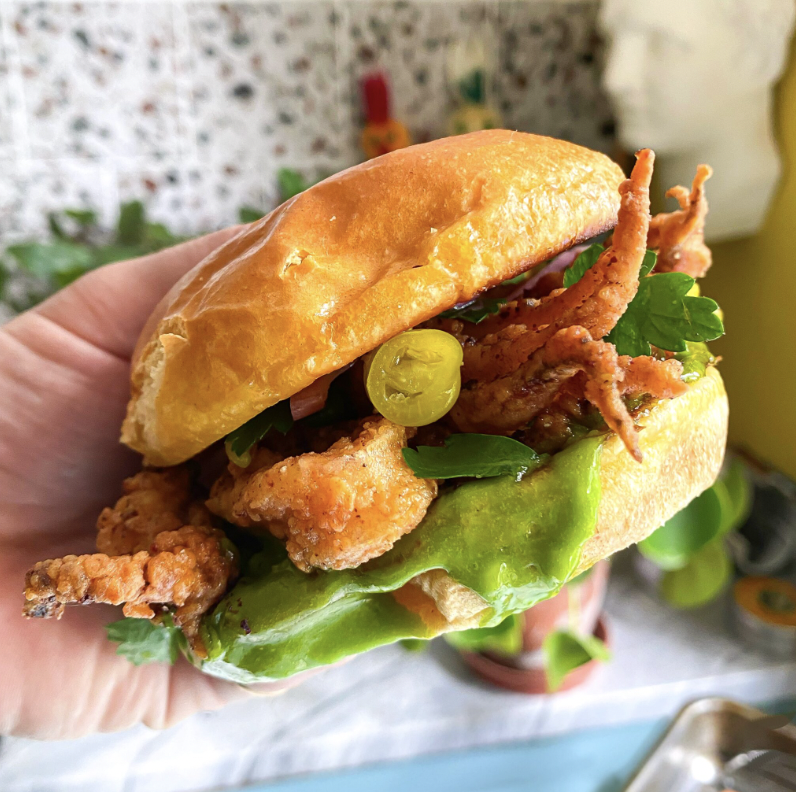
Ooof, now you’re talking (Credit: Twisted)
Looking for a spicy calamari recipe? Want that in a brioche bun, sir? Fancy a slathering of neon green home-made wild garlic mayo? Stick this in your face.
You can also use this mayo recipe in loads of other dishes. Pop it in a sandwich, dunk some chips in in it…we love a recipe with loads of uses!
Vegan Wild Garlic Tzatziki
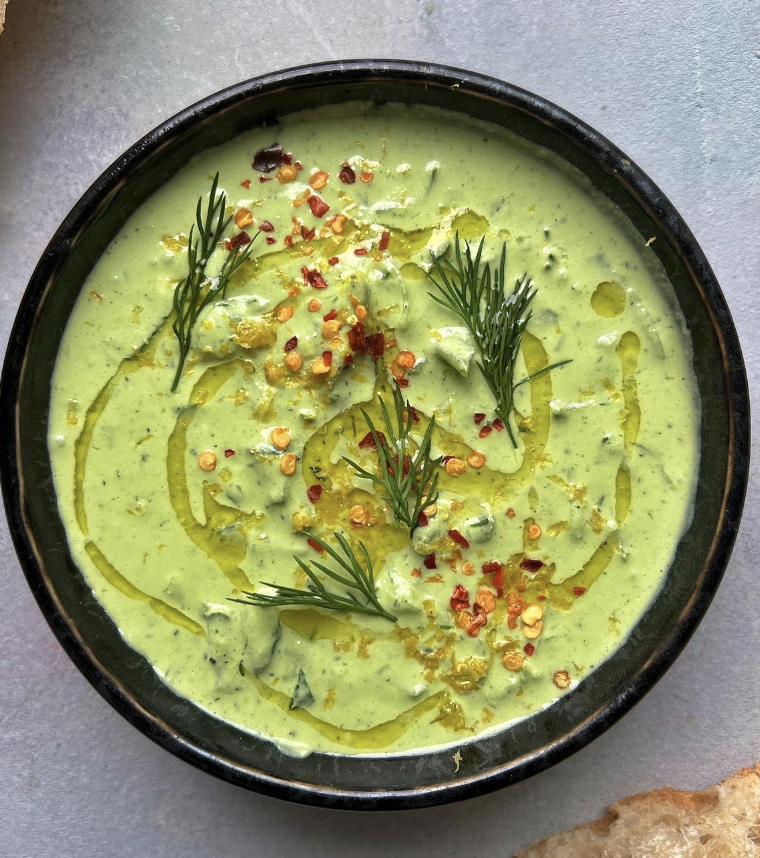
Wild garlic tzatziki, anyone? (Credit: Twisted Green)
Oh, hello! Yep, that’s a divine wild garlic and vegan feta tzatziki you’re feasting your eyes upon. We told you this stuff was the real deal.
Made with fresh dill, mint, cucumber and lemon, this is a spring treat for the senses. It smells as good as it looks and frankly we can’t think of anything we’d rather dunk some bread into.
Gourmet Cheesy Garlic Bread

Wild garlic bread? Don’t mind if we do (Credit: Twisted)
This is technically made with green garlic, but swapping wild garlic into this recipe would work smashingly.
Make a sexy wild garlic butter and then slather it on a lovely loaf alongside some cheese and we can all agree you’re in business. Sweet and mellow garlicky flavours will be gently cuddled by copious amounts of dairy.
Trust us, missing out any either of these would truly be wild…(sorry, we couldn’t help ourselves).



.jpg_dU0O4c?tr=w-2560,f-webp,q-70)